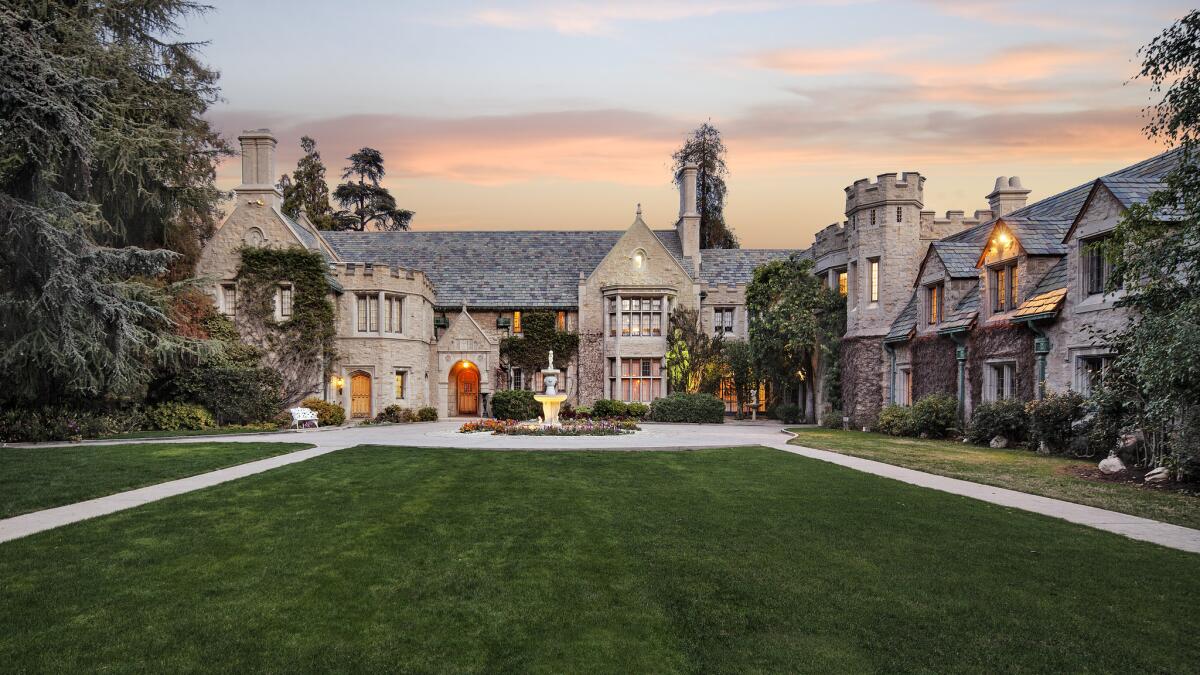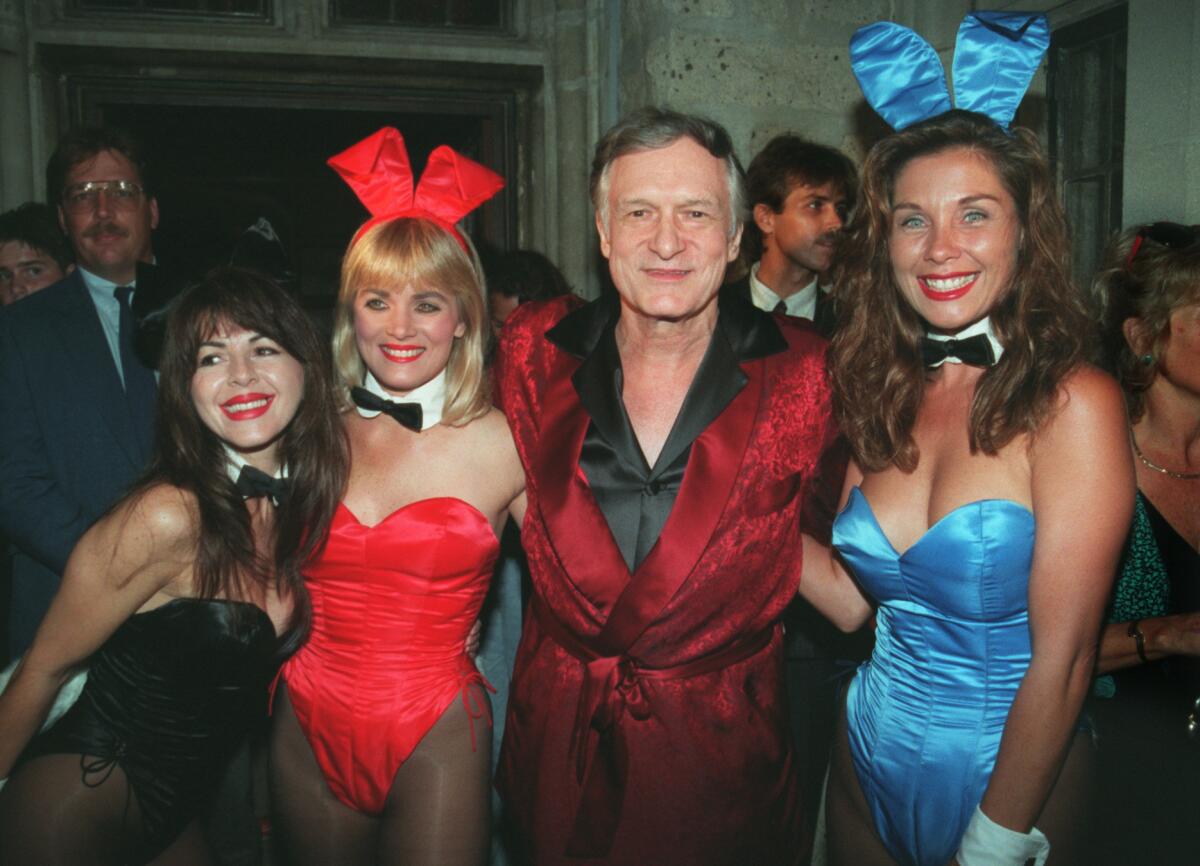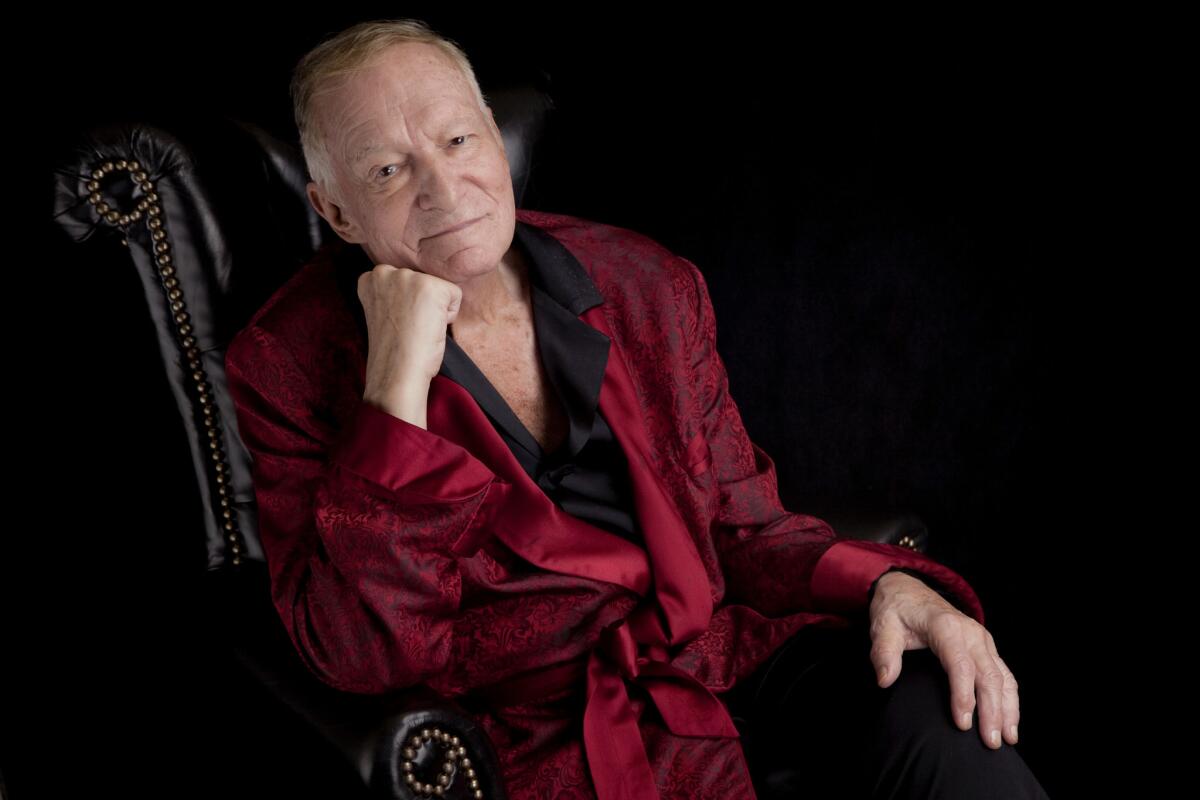Hugh Hefner’s Playboy Mansion was hedonistic headquarters for his brand
For all of Hugh Hefner’s contributions to publishing, pop culture and American attitudes about sex, he managed to also create a place that became almost as famous — or infamous — as the man himself.
The Playboy Mansion was one of many stately Gothic Tudor-designed spreads built for Los Angeles’ wealthy class in the boom years of the 1920s. But in the 1970s, Hefner turned one estate in Holmby Hills into an extension of his brand.
During the heights of its popularity, attending one of Hefner’s parties at the Playboy mansion was a sign of status, where one could rub elbows with celebrities, Playboy Bunnies and Hefner himself, often dressed in his trademark pajamas.

During the 1970s and early 1980s, the Playboy Mansion was perhaps L.A.’s most famous house, shorthand for a sexually liberated -- critics would say hedonistic -- party scene.
“It was such a lifestyle,” actress and model Pamela Anderson said several years ago. “Playboy Mansion was like my university. It was full of intellectuals, sex, rock ‘n’ roll, art, all the important stuff.”
But as times changed, so did views of the mansion and Hefner. Even in the 1970s, some decried what they saw as the exploitation of women and reckless sex it represented.
By the 1980s,
In more recent years, the mansion tended to trade on its risque reputation more than live up to it.
It became a popular spot for both private parties and political and charity fundraisers.
In 2005, the mansion was the setting for an E! reality show in which Hefner lived with three much younger companions.
The mansion was back in the news in 2014 when a woman claimed Bill Cosby molested her during a party there in 1974.
Hefner sold the mansion last year but continued to live there until his death Wednesday at 91.

A playpen and a zoo
When Hefner moved from Chicago to L.A., he transformed the Letts home into his Playboy Mansion — complete with redwood forest, aviary, hot-tub grotto and game house. Parties were frequent and wild. (The original Playboy Mansion was a 48-room place in Chicago with a circular rotating bed.)
Built in 1927 for department store scion Arthur Letts Jr., the Arthur R. Kelly-designed estate was acquired by Playboy in 1971 for about $1.1 million.
The Gothic Tudor-designed home of nearly 20,000 square feet has 29 rooms, including chef’s and catering kitchens, a game room, a wine cellar and a screening room with a built-in pipe organ. The master suite, one of 12 bedrooms, spans two floors.
Adding to its legend, the property is also among a select number of L.A. homes to have a zoo license. Aviaries and arboretums filled with exotic birds and monkeys are among structures on the grounds. Other birds and animals roam freely throughout the park-like setting.
Here’s a look back at the mansion from the pages of The Times:

‘The hedonistic dreams of my generation’
In 1988, Times columnist Al Martinez wrote about a visit to the mansion and how that home came to symbolize so much:
Hugh Hefner, bunnies and the Playboy Mansion symbolized the hedonistic dreams of my generation, and I was at long last coming to the mecca of Miss October. Above all, I wanted to look cool, but you can't look cool with a hole in your shoe.
I sighed and, accepting my unavoidable state of dishevelment, entered the mansion itself. I felt like Colombo at a White House reception, bumbling about in a raincoat at a party that required white tie and tails.
The reason I was at the mansion in the first place was to attend a press conference having to do with the 10th annual Playboy Jazz Festival that will be held in June at the Hollywood Bowl.
I have nothing to do with jazz and I'm not sure why I was invited to the conference, but I went because it afforded an opportunity to look at the mansion and maybe at one of those centerfold women who dance like dolls through the erotic fantasies of the young. Pubescent dreams die hard.
Shaken by AIDS and scandal
1994, The Times interviewed Hefner about how the AIDS crisis and other issues changed his empire and his mansion. An excerpt:
But with the dawn of the 1980s, the foundations of the Playboy empire were shaken. To many young people the magazine was either offensive or a curious anachronism. Circulation plummeted and, in short order, the company lost gambling licenses in London and Atlantic City. AIDS put the brakes on the sexual revolution. Dorothy Stratten, 1980 Playmate of the Year, was murdered by her husband amid allegations that Hefner was somehow linked to the tragedy. Then in 1985, Hefner had a stroke.
He made a quick and seemingly full recovery. But Hefner says he was forever changed by the experience. The announcement of his marriage made front-page news in 1989, and the once highly visible Hefner now jealously guards his new family's privacy.
Hefner wore his trademark silk pajamas for this interview. His Pepsi is now diet--and caffeine-free. Across an oversized backgammon table he talked of sex, gender and repression.
A different kind of house
By 2000, the mansion was being used more for fundraisers and private events than wild parties:
Not a week goes by when Hef's house isn't hosting a party for as few as 15 people or as many as 1,500. But if the mansion's mere mention conjures images of barely dressed Playmates and pajama-wearing suitors, the image is not always the reality.
Over the years, the mansion has hosted many a political event, featuring the likes of former Gov. Jerry Brown, former Los Angeles Mayor Tom Bradley and even presidential candidates — from John B. Anderson to Eugene J. McCarthy.
Over the years, Hefner has used his publishing empire — and his world-famous parties — as a sort of Bunny pulpit. Railing against the Vietnam War, supporting the civil rights movement or endorsing abortion rights.

Last days of the playboy
Last year, Daren Metropoulos, the son of billionaire investor C. Dean Metropoulos, purchased the compound for $100 million. The Times reported at the time:
The mansion sold for $100 million, the biggest home sale ever recorded in Los Angeles County.
As part of the sale, Hefner will be allowed to remain in residence for the remainder of his life; Playboy Enterprises will pay $1 million a year to lease the property, according to agents not authorized to comment on the transaction. All the statues, gargoyles and arcade games at the mansion were also included in the record deal.
“The Playboy Mansion is one of the most iconic properties in the world and the crown jewel of Holmby Hills and the platinum triangle,” Metropoulos said at the time. “For the last 45 years, Mr. Hefner has imbued the estate with a rich and storied legacy.”
ALSO
Playboy's Hugh Hefner has died. He once said he had 'an adolescent dream of an adult life'
Sign up for Essential California
The most important California stories and recommendations in your inbox every morning.
You may occasionally receive promotional content from the Los Angeles Times.








